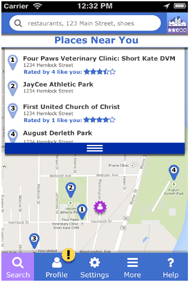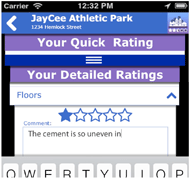AccessPlace: Personalized Accessibility information for buildings
Nathan Spaeth, Dennis B. Tomashek, Roger O. Smith
R2D2 Center, University of Wisconsin-MilwaukeeIntroduction
A set of applications was developed to assist in the accessibility assessment of buildings: the AccessTools suite and AccessPlace. Together, they form the NIDRR funded Access for Buildings Project. AccessTools is a suite of iOS mobile applications designed for use by trained raters to evaluate the accessibility of buildings. AccessPlace is a multi-platform mobile and web application designed for end-users to communicate and obtain Personalized Accessibility Information (PAI) tailored for the individual’s functional impairments.
Problem
In face of uncertain accommodations, people with disabilities (PWD) can be apprehensive about visiting unfamiliar venues, encountering unique challenges when planning ordinary activities such as errands and social outings. Concerns, such as whether there will be sufficient lighting, accessible bathrooms, if there is available assistance, or fear of being burdensome can deter individuals from risking independent trips or from participating in social activities (King, Castro, Wilcox, Eyler, Sallis, & Brownston, 2000; Glass, Balfour, 2003; Michael, Green, & Farquhar, 2006).
Seeing no clear recourse for improving the state of affairs can induce a sense of helplessness and resignation. To cope, many choose an avoidant strategy of forgoing participation in experiences that take place in unfamiliar places. Together, these obstacles highlight a need for readily available Personalized Accessibility Information (PAI), which gives PWD information tailored to their particular set of functional impairments. This allows PWD and their companions the freedom to more easily engage in new activities.
Existing Approaches

Popular commercial entities such as Yelp®, Google Places® and Foursquare® include limited accessibility information, namely a dichotomous accessible-or-not indicator that is confined only to wheelchair accessibility, rather than a more nuanced grading. This completely ignores other impairment groups. On the rare occasion that users provide comments oriented toward accessibility, they are lost in a sea of otherwise informative reviews, making the comments of limited utility for making accessibility related decisions. Further, the data may not address the particular users’ functional impairments.
Other resources are local ad-hoc web communities geared toward particular disability populations that take the form of forums or curated reviews (disabilities-r-us; yourable). These resources contain information that is highly relevant to the given population, and can promote a sense of community. However, due to the large number of functional impairments (Smith, et al. 2007), and the number of people with more than one significant disability, these resources may not meet the needs -of individuals, and are not specific to building accessibility.
With the available resources, researching destination accessibility becomes a time consuming process that interferes with the freedom of more spontaneous experiences. Mobile computing technology offers the opportunity for quick, personalized information entry and retrieval.
Final Design
Objectives

Additionally, we identified three criteria for a resource to meet in order to provide significant improvement over the status quo: 1) Data must be highly relevant to the individual, implying a broad scope across disability populations could be less relevant, 2) Data must be quickly accessible to allow for spontaneity and minimal interruption 3) Data must be easily accessible to a wide range of disabilities, with particular attention to those with visual or motor impairments – targeted users are more likely to be in need of these features than users of resources meant for a broader population.
Implementation

Crowdsourcing is implemented in an extended review format, where a normal user is capable of submitting accessibility related information on a variety of facility features. The crowdsourcing aspect simultaneously achieves objective 3.
User friendly web and mobile interfaces were developed to interface with an in-common database to facilitate access to relevant accessibility information as it pertains to particular facilities. Each of the identified minimal criteria are achieved through various interface design decisions.
Criteria 1
Relevance to the individual is achieved through Functional Impairment Profiles. On user account creation, users are prompted to follow a step-by-step profile creation process. The user is asked to assess their ability or inability to perform certain functional tasks on spectrum spanning from ‘no difficulty to ‘not capable’ (fig. 1).
The submitted user assessments are automatically numerically coded into a multi-dimensional vector representing their unique profile. When accessing accessibility information for a facility, this vector is compared to the vectors of the users who have submitted reviews for that facility. Reviews whose users’ have similar vectors are sorted toward the top of the list, and their ratings are given greater weight in correspondence to their level of similarity (fig. 2). Reviews by dis-similar reviewers are filtered out.
Criteria 2

After selecting a location, the user is prompted to select whether they want to read reviews (fig. 2), or review the selected location (fig. 5). This allows users to easily submit useful feedback while minimally interrupting their current activities.
Criteria 3

Discussion & Implications
Pilot data suggest that PWD would use a tool like AccessPlace to plan future outings to restaurants, especially if this information was combined with standard reviews. The pilot data also suggest that PWD like the idea of information that is tailored for them. Challenges for developing this type of crowd-sourced platform is that it is highly dependent on users to populate, and thus has a critical mass below which it is of little use. Thus, plans for widely, advertising and distributing the app to the appropriate populations are imperative. A second challenge of this type of app is ensuring the reliability and validity of the user entered data. Again, this is highly dependent on the community of users to self-police, reporting inappropriate or erroneous information.
Solutions include partnering with an already established entity that has wide distribution and use, such as Yelp. A method of advertising is to contact the Independent Living centers (both private and government run) to ensure that the populations who would most benefit from this app are aware of it.
A major barrier to community participation for many PWD is the lack of information available about the accessibility of public buildings. An app like this, once populated, would allow PWD to better plan outings, and thus feel more confident about going out into the community.References
Americans with Disabilities Act (2010). Retrieved January 13, 2014 from http://www.ada.gov/pubs/adastatute08.htm
disabilities-r-us retrieved January 13, 2015 from http://www.disabilities-r-us.com/
Glass, T. A., & Balfour, J. L. (2003). Neighborhoods, aging, and functional limitations. Neighborhoods and health. I. Kawachi and L. f. Berkman. New York, NY, Oxford University Press, Inc.: 303-334.
King, A. C., C. Castro, et al. (2000). "Personal and environmental factors associated with physical inactivity among different racial-ethnic groups of U.S. middle-aged andolder-aged women." Health Psychology 19(4): 354-364.
Michael, Y. L., Green, M. K., & Farquhar, S. A. (2006). "Neighborhood design and active aging." Health and Place 12(4): 734-740.
Smith, R. O., K. Barnekow, et al. (2007). Development of the Medical Equipment Device Accessibility and Universal Design Information Tool. Medical instrumentation: Accessibility and usability considerations. J. M. Winters and M. F. Story. Boca Raton, FL, CRC Press: 283-296.
youreable retrieved January http://www.youreable.com/forums/forum.php